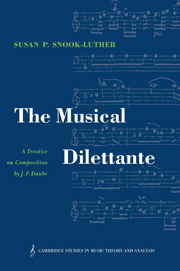Book contents
- Frontmatter
- Contents
- Foreword
- Translator's preface
- Introduction
- THE MUSICAL DILETTANTE: A TREATISE ON COMPOSITION (1773)
- Preface
- 1 Harmony in general
- 2 The three different motions of the voices
- 3 Combining two voices
- 4 Combining three voices
- 5 Combining four voices
- 6 Composition in five and more parts
- 7 Variation
- 8 Imitation
- 9 Canon
- 10 Simple fugue
- 11 Double counterpoint
- 12 Double fugue
- Bibliography
- Index
1 - Harmony in general
Published online by Cambridge University Press: 15 October 2009
- Frontmatter
- Contents
- Foreword
- Translator's preface
- Introduction
- THE MUSICAL DILETTANTE: A TREATISE ON COMPOSITION (1773)
- Preface
- 1 Harmony in general
- 2 The three different motions of the voices
- 3 Combining two voices
- 4 Combining three voices
- 5 Combining four voices
- 6 Composition in five and more parts
- 7 Variation
- 8 Imitation
- 9 Canon
- 10 Simple fugue
- 11 Double counterpoint
- 12 Double fugue
- Bibliography
- Index
Summary
Harmony is an arrangement of several tones or voices which are combined artificially so as to best obtain the final aim, which is to please the ear. It is presented in various ways: through the realization of the thorough-bass, whenever nothing but chords, all of which must be harmonic, are heard on the harpsichord etc.; or by various other instruments each playing a separate melodic line as, for example, in a fugue, where much artistic [elaboration] is displayed, or in a slow piece consisting mostly of chords. Here this same harmony is already more widely dispersed, while the diverse note values which occur, and similarly the passing tones, ornaments, etc., direct the harmony toward an effect altogether different from that which might result from a realization of the thorough-bass. Now if the harmony is expressed by voices and instruments together, the result can be even better, provided the execution is good. Every amateur knows how much singing contributes to the expression of the affects. The human voice always remains the most noble means of expressing them, particularly when it has been well supported by nature and art. What even nature alone is able to do in this regard, and how it directs even the purest part of the harmony toward expressing certain affects, is found by listening to the sacred hymns which are sung by many persons together.
- Type
- Chapter
- Information
- The Musical DilettanteA Treatise on Composition by J. F. Daube, pp. 37 - 41Publisher: Cambridge University PressPrint publication year: 1992



